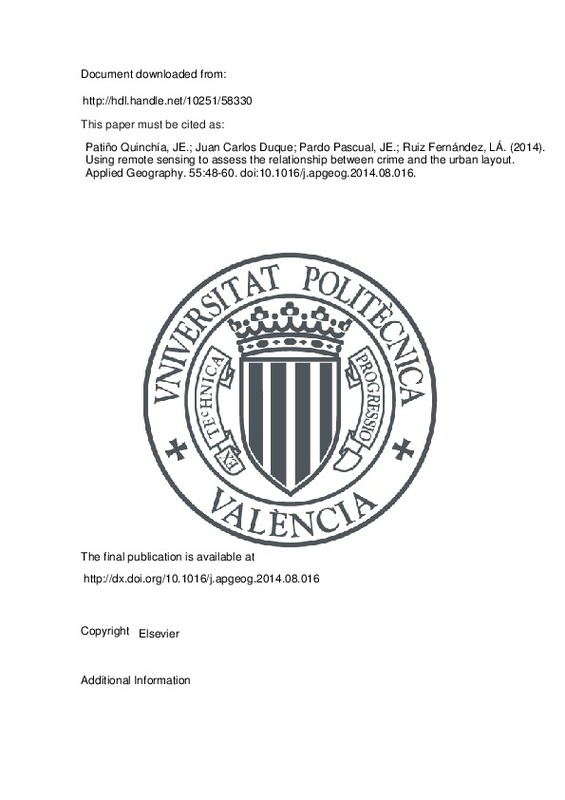JavaScript is disabled for your browser. Some features of this site may not work without it.
Buscar en RiuNet
Listar
Mi cuenta
Estadísticas
Ayuda RiuNet
Admin. UPV
Using remote sensing to assess the relationship between crime and the urban layout
Mostrar el registro sencillo del ítem
Ficheros en el ítem
| dc.contributor.author | Patiño Quinchía, Jorge Eduardo
|
es_ES |
| dc.contributor.author | Duque, Juan Carlos
|
es_ES |
| dc.contributor.author | Pardo Pascual, Josep Eliseu
|
es_ES |
| dc.contributor.author | Ruiz Fernández, Luis Ángel
|
es_ES |
| dc.date.accessioned | 2015-11-30T15:01:40Z | |
| dc.date.available | 2015-11-30T15:01:40Z | |
| dc.date.issued | 2014-12 | |
| dc.identifier.issn | 0143-6228 | |
| dc.identifier.uri | http://hdl.handle.net/10251/58330 | |
| dc.description.abstract | [EN] The link between place and crime is at the base of social ecology theories of crime that focus in the relationship of the characteristics of geographical areas and crime rates. The broken windows theory states that visible cues of physical and social disorder in a neighborhood can lead to an increase in more serious crime. The crime prevention through environmental design (CPTED) planning approach seeks to deter criminal behavior by creating defensible spaces. Based on the premise that a settlement's appearance is a reflection of the society, we ask whether a neighborhood's design has a quantifiable imprint when seen from space using urban fabric descriptors computed from very high spatial-resolution imagery. We tested which land cover, structure and texture descriptors were significantly related to intra-urban homicide rates in Medellin, Colombia, while controlling for socioeconomic confounders. The percentage of impervious surfaces other than clay roofs, the fraction of clay roofs to impervious surfaces, two structure descriptors related to the homogeneity of the urban layout, and the uniformity texture descriptor were all statistically significant. Areas with higher homicide rates tended to have higher local variation and less general homogeneity; that is, the urban layouts were more crowded and cluttered, with small dwellings with different roofing materials located in close proximity to one another, and these regions often lacked other homogeneous surfaces such as open green spaces, wide roads, or large facilities. These results seem to be in agreement with the broken windows theory and CPTED in the sense that more heterogeneous and disordered urban layouts are associated with higher homicide rates. | es_ES |
| dc.description.sponsorship | This research was made possible by funding from EAFIT University (EAFIT-435-000060) and the Medellin City Hall EnlazaMundos program. The authors thank the anonymous reviewers and Hermilson Velazquez, Andr es Ramírez Hassan and Gustavo Canavire for their insightful observations and suggestions during the different stages of this project | |
| dc.language | Inglés | es_ES |
| dc.publisher | Elsevier | es_ES |
| dc.relation.ispartof | Applied Geography | es_ES |
| dc.rights | Reserva de todos los derechos | es_ES |
| dc.subject | Homicide | es_ES |
| dc.subject | Remote sensing | es_ES |
| dc.subject | Urban layout characterization | es_ES |
| dc.subject | VHR imagery | es_ES |
| dc.subject.classification | INGENIERIA CARTOGRAFICA, GEODESIA Y FOTOGRAMETRIA | es_ES |
| dc.title | Using remote sensing to assess the relationship between crime and the urban layout | es_ES |
| dc.type | Artículo | es_ES |
| dc.identifier.doi | 10.1016/j.apgeog.2014.08.016 | |
| dc.relation.projectID | info:eu-repo/grantAgreement/EAFIT//EAFIT-435-000060/ | es_ES |
| dc.rights.accessRights | Abierto | es_ES |
| dc.contributor.affiliation | Universitat Politècnica de València. Departamento de Ingeniería Cartográfica Geodesia y Fotogrametría - Departament d'Enginyeria Cartogràfica, Geodèsia i Fotogrametria | es_ES |
| dc.description.bibliographicCitation | Patiño Quinchía, JE.; Duque, JC.; Pardo Pascual, JE.; Ruiz Fernández, LÁ. (2014). Using remote sensing to assess the relationship between crime and the urban layout. Applied Geography. 55:48-60. https://doi.org/10.1016/j.apgeog.2014.08.016 | es_ES |
| dc.description.accrualMethod | S | es_ES |
| dc.relation.publisherversion | http://dx.doi.org/10.1016/j.apgeog.2014.08.016 | es_ES |
| dc.description.upvformatpinicio | 48 | es_ES |
| dc.description.upvformatpfin | 60 | es_ES |
| dc.type.version | info:eu-repo/semantics/publishedVersion | es_ES |
| dc.description.volume | 55 | es_ES |
| dc.relation.senia | 272067 | es_ES |
| dc.contributor.funder | Universidad EAFIT, Colombia |







![[Cerrado]](/themes/UPV/images/candado.png)

